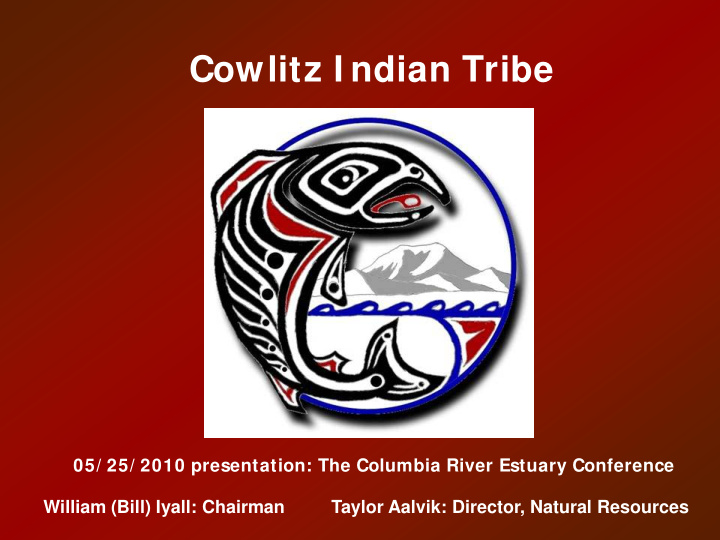



Cowlitz I ndian Tribe 05/ 25/ 2010 presentation: The Columbia River Estuary Conference William (Bill) Iyall: Chairman Taylor Aalvik: Director, Natural Resources
History Overview • Negotiated at the Chehalis River Treaty Council in 1855 (negotiations failed). • 1855 – 1900: Many members scattered to different areas of SW Washington & NW Oregon, some driven by force to other reservations. • Some families were able to survive and stay in homelands and others returned after forced removal. • Pursued Congressional Recognition during early 1900s (17 bills before Congress; one bill that passed both houses vetoed by Calvin Coolidge in 1928).
• Pursued land claims under Docket 218 with the Indian Claims Commission. In 1973, ICC determined 1.66 million acres exclusively used and occupied by the Cowlitz People. • Became Federally Acknowledged Tribe in 2000 (appeal of decision upheld in 2002).
Our Environment Can be Described as one of the Most Dynamic in the World Mount St. Helens - 1847 Mount St. Helens - 2004 Smelt Dipping 2010
Lower Columbia Estuary Culturally Important to Tribe Provided For: • Resource Harvest, Inter-Tribal Trading, Travel Corridors, Inter-Tribal Gatherings, etc. • The estuary environment is a part our traditions, legends, folklore and many other components of our way of life important to existence. Key Fishing Area (Oak Point) Smelt Harvest Columbia River Wapato Harvest Canoe travel 2009
Cowlitz Indian Tribe Natural Resources Department (NRD) Mission: To conserve, protect, and restore culturally- significant natural resources within traditional homelands. This mission benefits Tribal members today and future generations to come. Cultural Survival is important to our very existence and it honors who we are as individuals and as a people.
Lower Columbia River A holistic view of the environment is important to the Tribe when planning for restoration (i.e. habitat connectivity, water quality/flows, plants, animals, fish, forests, marshlands, limiting factors, etc.)
Partnerships Key to Adaptive Management of the Columbia River Estuary • We live in a new diverse environment with multiple stakeholders with multiple goals. • In many cases competing or overlapping goals. Lower Lewis River woody debris restoration • Partnerships and communication • Good faith collaboration of all stakeholders provides positive communications leading to hopeful success towards restoration. Wapato Columbian White-tailed deer
Sample Partnerships 1. US Fish & Wildlife Service 2. US Army Corps of Engineers 3. National Oceanic and Atmospheric Administration 4. US Environmental Protection Agency 5. US Forest Service - Gifford Pinchot National Forest 6. Lower Columbia Fish Recovery Board 7. Washington Department of Fish and Wildlife 8. Washington Department of Natural Resources 9. PacifiCorp 10. Tacoma Power 11. Lower Columbia Fish Enhancement Group 12. The Nature Conservancy 13. Other Tribes and Inter-Tribal Consortiums California Condor
Shannon Wills David Russell Ed Arthur Erik White Rudy Salakory Nathan Reynolds
Recommend
More recommend